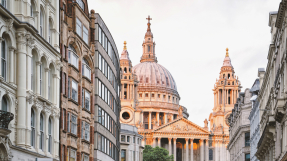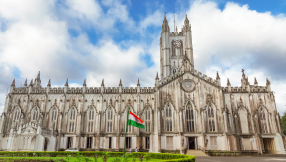Imagine the first Christmas with Jesus born not in a stable but a cave. There are no angels and shepherds but instead the sheep in the fields, the birds in the air and the clouds in the sky stand still, astonished. In fact, the whole earth is seen to pause for a moment.
A midwife descends from a mountain. She is singing the song that is now called the Magnificat: 'This day my soul is magnified,' she declares. Then, a bright cloud descends, dazzling everyone until Jesus appears.

This is the story that will be rehearsed by many Christians. It's the version known by members of the Eastern Orthodox churches. The details come from a text that was popular in the early church, though it didn't make it into the New Testament – the Gospel of James, named after the brother of Jesus.
It shapes the Christmas of churches in the East because this nativity scene is also the one written on icons. These holy pictures, that are said to be windows from heaven, invariably show Mary in a cave under a mountain, attended by other women. The jagged rocks among which she rests are pierced by a burst of light from on high.
It's an image replete with symbolism that, to my mind, the western world and western churches are in urgent need of because, at heart, it makes clear that Christmas remembers a spiritual eruption. It transforms everything from the inside out.
Take the setting, in a cave. Grottos and hillside fissures were powerful places in the Hellenistic world that profoundly shaped the Judaism into which Jesus was born. Plato had written about enlightenment as escaping from a cave. They were also regarded as secret spots that concentrate divine energy. Mystical rites were conducted within them. 'Icons of the nativity depict this version of the event where the cave does indeed seem to be the focal point of cosmic energies,' writes Richard Temple in Icons and the Mystical Origins of Christianity.
Further details show other spiritual truths. The sheep, birds and clouds standing still suggest that, at that moment, the consciousness of the whole world focused on the tremendous occurrence. The bright light descended. Divine life from a higher realm was flowing into the wilderness and stone.
Incidentally, discussing the symbolism is not meant to imply that the details are not historical. Bethlehem is surrounded by mountains and habitable caves. Mary and Joseph could easily have found one. In fact, some historians have concluded that it's more likely than them resting in a stable.

But why might this spiritually loaded recollection of the birth of Jesus matter today? It's because we live in an age that struggles to see how natural events are divine manifestations.
Modern science, for all its numerous advantages, has distracted us from the sacred pulse that runs through the cosmos. It has reduced the living dynamic called the Logos to mechanical laws of nature. Even Christians can have eyes that barely see, ears that barely hear, and so mouths that rarely speak of it. I sense it whenever an apologist tries to reconcile Christianity with science, or demonstrate that the events of Jesus's life, death and resurrection are as provable as Newton's second law of motion.
The efforts never fully satisfy because they miss the main point. Jesus' birth is not primarily an historical event, though it was that. It's a spiritual one. Its importance is not because of what happened 2,000 years ago, but because of what can happen now, for us all. It's about spiritual birth, divine life and knowing the incarnate presence throughout the cosmos – even in the hard, hidden places.
Know that and it becomes possible to tell different stories to illuminate the multitudinous aspects of the central truth. Matthew, Luke and James must have felt they were doing so when they wrote their diverse accounts of the nativity in their gospels.
Such imaginative retellings are far from how the Christmas story is captured nowadays. Bishops and ministers often seem fixated on interpreting it as if the meaning were thoroughly this-worldly and secular. The holy family are commonly described as migrants, with Jesus said to have been born into poverty and/or an unconventional family.
But Christianity's spiritual revolution is reduced by focusing on its social significance and, while it clearly does have a bearing upon how we relate politically and economically, my sense is that when the higher vision is eclipsed, its power to penetrate to the root of problems diminishes, too. Climate change and material inequality and restless hearts are not fundamentally social issues. They are, at base, perceptual. Do we have eyes that can see, ears that can hear, and mouths that can speak of an entirely different order of reality? Can we know it in our hearts and so, as a byproduct, realign our lives to it?
The message of Christmas is that we can awaken to new life. It's born within us, much as the child was born in a buried cave. The way he showed is from darkness to light, from obscurity to sight, from death to life. It's true because the divine energy, which early Christians saw in Christ, can be seen filling the entire universe. We can know it, with spiritual sight, today.
Mark Vernon's new book, 'A Secret History of Christianity: Jesus, the Last Inkling, and the Evolution of Consciousness', will be published next year. For more, see www.markvernon.com













